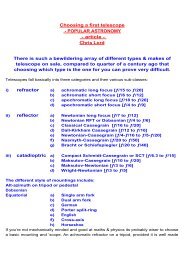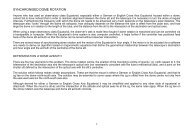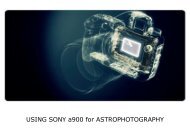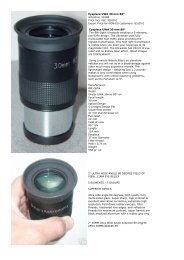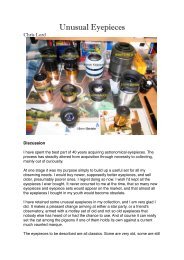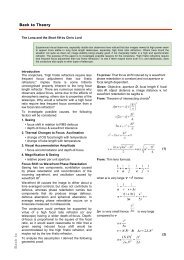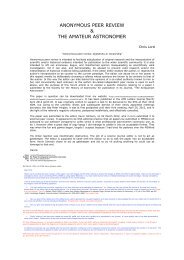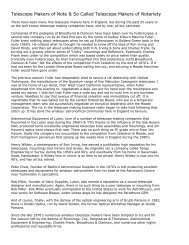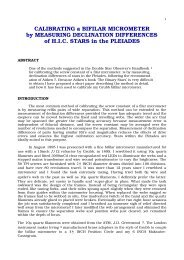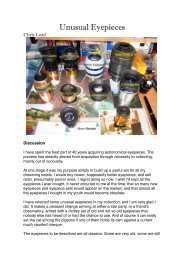Evolution of the Astronomical Eyepiece - Brayebrook Observatory
Evolution of the Astronomical Eyepiece - Brayebrook Observatory
Evolution of the Astronomical Eyepiece - Brayebrook Observatory
Create successful ePaper yourself
Turn your PDF publications into a flip-book with our unique Google optimized e-Paper software.
EVOLUTION <strong>of</strong> <strong>the</strong> ASTRONOMICAL EYEPIECE<br />
Reflection losses may be quantified in terms <strong>of</strong> <strong>the</strong> refractive index gradient at <strong>the</strong> media<br />
boundary, hence:<br />
⎧ ⎪ ⎛<br />
k = 1− µ − µ ⎞<br />
1 2<br />
⎨ ⎜ ⎟<br />
⎩ ⎪ ⎝ µ 1 + µ 2 ⎠<br />
2<br />
⎫ ⎪ ⎧ ⎪<br />
⎬<br />
⎭ ⎪ 1 − ⎛ µ − µ ⎞<br />
2 3<br />
⎨ ⎜ ⎟<br />
⎩ ⎪ ⎝ µ 2 + µ 3 ⎠<br />
2<br />
⎫ ⎪ ⎧<br />
⎬<br />
⎭ ⎪<br />
........... ⎪<br />
1 − ⎛ µ − µ ⎞<br />
n−1 n<br />
⎨ ⎜ ⎟<br />
⎩ ⎪ ⎝ µ n −1 + µ n ⎠<br />
2<br />
⎫ ⎪<br />
⎬<br />
⎭ ⎪<br />
for a cemented surface where:<br />
µ 1<br />
= µ 2<br />
=1.5<br />
(Canada balsam or Xylol)<br />
and where:<br />
µ 3<br />
=1.7 k = 0.39%<br />
µ 3<br />
=1.8 k = 0.83%<br />
µ 3<br />
=1.9 k =1.38%<br />
µ 3<br />
= 2.0 k = 2.04%<br />
and at an air-glass surface where:<br />
µ 2<br />
=1.0<br />
µ 1<br />
=1.5 k = 4.0%<br />
µ 1<br />
=1.6 k = 5.33%<br />
µ = 1.7 k = 6.72%<br />
µ 1<br />
= 1.8 k = 8.16%<br />
µ 1<br />
= 1.9 k = 9.63%<br />
µ 1<br />
= 2.0 k =11.11%<br />
It is <strong>the</strong>refore evident that reflection<br />
losses from an air-glass surface are<br />
greater than from a cemented surface,<br />
but <strong>the</strong>y also increase with <strong>the</strong> index<br />
gradient. Because <strong>the</strong> refractive index<br />
<strong>of</strong> glass changes with wavelength (dispersion),<br />
r eflection losses vary across<br />
<strong>the</strong> spectrum, which is why ghosts<br />
<strong>of</strong>ten assume a specific hue.<br />
Anti-r eflection coatings, developed in<br />
<strong>the</strong> late 1930’s can virtually eliminate<br />
reflection at air -glass surfaces. The<br />
principle involved is <strong>the</strong> suppression <strong>of</strong><br />
<strong>the</strong> reflected incident ray by destructive<br />
interf e rence, ba lanced by constructive<br />
interference in <strong>the</strong> transmitted<br />
pencil arising from reflection within<br />
<strong>the</strong> film.<br />
This can occur when <strong>the</strong> square <strong>of</strong> <strong>the</strong><br />
12<br />
coating index equals <strong>the</strong> glass index,<br />
<strong>the</strong> optical thickness <strong>of</strong> <strong>the</strong> film being a<br />
quarter wave. Herein though lies <strong>the</strong><br />
first difficulty, for:<br />
µ<br />
f or crown a nd flint glass are<br />
respectively 1.231 & 1.271, and<br />
no solids have refractive indices as low<br />
as this. Among <strong>the</strong> nearest are lithium<br />
fluoride ( µ=1.39, reducing <strong>the</strong> loss from<br />
between 4% - 5%, to a <strong>the</strong>oretical<br />
0.1%,- nearer 1.5% in practice - over<br />
<strong>the</strong> visual spectrum); calcium fluoride<br />
(µ=1.34); sodium and magnesium fluorides;<br />
m agnesium chl oride; silicon<br />
dioxide (µ=1.46); cryolite and certain<br />
fatty acids.<br />
None <strong>of</strong> <strong>the</strong>se are perfect: lithium fluoride<br />
is fragile and soluble in water,<br />
hence useless for outer surfaces;



